Foreign Insulators
by Marilyn Albers
Reprinted from "Crown Jewels of the Wire", February 1996, page 8
THIS ONE'S AUTHENTIC, FOLKS!
It has come to my attention that "someone" out there in
"readerdom" has questioned whether or not a certain specimen of U-2725
should be considered a genuine and legitimate collectible insulator. I
personally think it should be and I stand 100% behind its authenticity. Since I
was not told who "someone" is, I sincerely hope that he/she is reading
this article and will come forth to discuss it with me in daylight. I will tell
you what I know about this insulator and if anyone else has some thoughts to
add, positive or negative, please let me hear from you. I'll listen and will be
happy to include your responses in my next article, which will appear in the
April issue. I'll need them by February 24th.
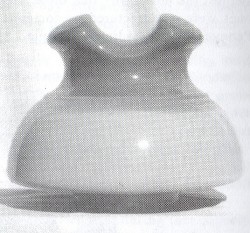
The particular U-2725 under
suspicion was made by AI (Allied Insulators) Industrial Products Ltd. at their
plant in Stoke-on-Trent, England. It stands 4-1/4" tall and has a skirt
diameter of 5-5/8". The insulator is glazed a lovely soldier blue from the top of its crown down through the wire groove,
where it meets a 1/2" band of pinky mauve, and then blends into a light
blue gray from there on down to the base of the extended petticoat. Both front
and side views of the insulator are shown below (how I wish you could see it in
color!). In the second photo you can see the" A I" logo and the date
of manufacture, indicated by the numbers 3-90, or March, 1990. AI came into
being in 1959 with the merger of two older insulator manufacturers in England,
Bullers Ltd. and Taylor, Tunnicliff & Co. Ltd. In addition to the U-2725, the company produces
several other styles of low and high voltage insulators for telecommunications
lines and electric railways.
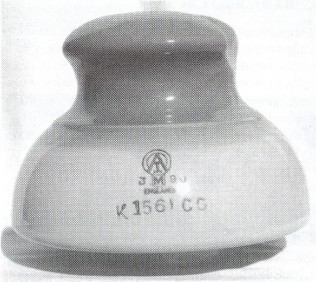
Here's the story on the U-2725: In late 1989 a
British collector, who had long admired the lovely two-tone blue glaze he had
seen on larger AI power insulators, went to the factory and asked if they could
include a few U-2725's the next time they were applying that blue glaze to the
larger pieces. (U-2725 was his favorite style and he knew that various glaze
colors could be applied to the insulators, depending on the wishes of the
particular user.) Since this was to be a small order, he gave his word that he
would buy them. They were willing to cooperate and promised to call him when
they finished the next batch of blue insulators. It was March of 1990 when they
finally notified him and he was true to his word. I do not know how many he took home but he did share
a few with other collector friends in England. He sold me a total of five, one
of which is in my collection, and four that quickly found homes with other
collectors here in the States.
On the following page you see the U-2725 alongside
one of the larger blue power pieces, which came from an earlier batch of AI
insulators produced in February of 1989. The next photo shows the AI logo and
date on that larger one. I got this insulator from a different source. Ross Huth
of Porterville, California (whom we all miss, bless him) traveled to England
with his church choir sometime during 1989 or 1990. Being a collector, he also
admired the pretty blue insulators up on the lines.
He wanted one but didn't
have time to track it down, so someone there promised to get one for him at the
factory. That effort was successful and the insulator was hand-carried back to
Ross the next time this friend made a trip to the States. Knowing my passion for
foreign insulators, Ross brought his treasured blue insulator to the 1994 NIA
National Show in Houston and gave it to me as a gift! If you knew Ross, you were aware that he couldn't do enough for his friends.
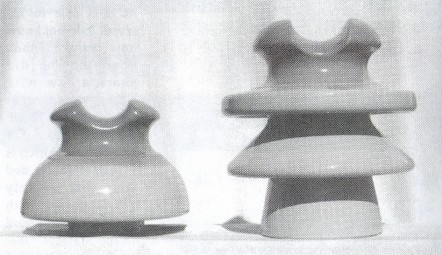
Both of these insulators are dead mint and have never been used on a line
because they came directly from the AI plant. Shall we call that a "no brainer"? A threaded
metal thimble is cemented into the pin hole of each. The U-2725 was specifically
ordered in a blue glaze by an individual admirer, while the taller one was part
of a much larger batch ordered by a utility company, one of which ended up in
the hands of a California admirer. Question: Would you consider the blue U-2725
a genuine collectible insulator? May I have your comments?
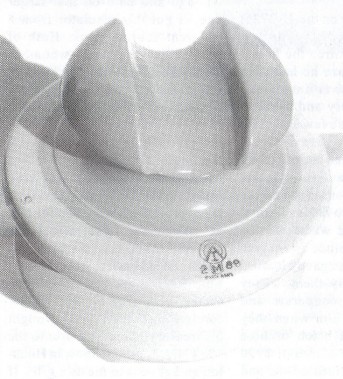
HOW IS YOUR ARABIC?
"Glass Insulators from Outside North America" lists a CD 128 in
light sage green embossed with a strange looking symbol or trademark, which we
guessed might be Arabic. We had no real leads, but because it was a fairly
modern style and in really great condition, we figured it couldn't be very old.
It certainly wasn't from North America. Woody says Corning was the only company
producing the CD 128 from about 1923 until the late 1930's, and these all had
ridges down into the skirt. Other U.S. companies began making them at a later
date, and European manufacturers even later than that, probably in the 1960' s.
Woody faithfully traced the embossing so it could be included in the book, and
we've been hoping ever since that someone would recognize it and come forth with
some information on this insulator. There wasn't a squeak from any direction
until about mid-November of '95 when I received a call from David Sztramski
(Cranford, NJ). He tried to describe a strangely embossed CD 128 in straw that
his mother had found in a local antique shop, but it didn't sound like anything
we had seen before, so he agreed to let us borrow it. As soon as I opened the
box I saw that it actually was the same embossing as found on the sage green
one, except this trademark had more parts to it and some pretty different
squiggles underneath it. The first one had not really been complete. This was
exciting! This new version of the marking began to look more and more like Arabic, so
I called on
my daughter Margaret, who teaches English to foreign students, including those
who speak Arabic, hoping she could help us solve the puzzle.
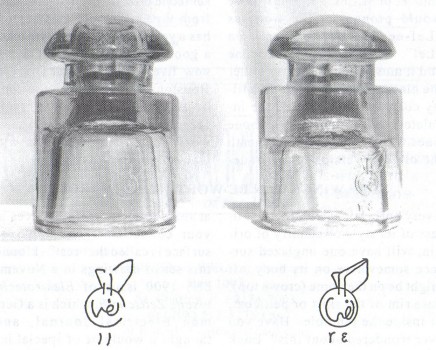
Shown on the
previous page are the two trademarks along with a photo of both CD 128's.
Here
is what we have been able to learn. With the help of Shahid Khan, a student from
Pakistan, we know that there are three stylized Arabic letters joined together
in script inside the circle. These letters are "I F L", if you read
them left to right as we do in English. However, Arabic letters are meant to be
read right to left, so to anyone speaking that language, they become "L F
I", with an "E" implied between the "L" and "F, or
"LEFI". In English we would pronounce the word as "Lef-eee",
with emphasis on "Lef". This is actually a name and it most likely
indicates either the glass manufacturer or the utility company that ordered the
insulators for use on local telephone lines. The squiggles underneath the
original version of the trademark turned out to be mold number "11" and those under the new,
more legible version are for mold number "24". Oddly enough, Arabic
numbers are read from left to right, just as we do in English. How's that for
inconsistency?
Until we know the actual name of the manufacturer or user, it
will really be hard to pinpoint a country of origin because the Arabic language
is spoken in several countries, including Saudi Arabia, Egypt, Libya, Tunisia,
Algeria, Morocco, Pakistan, Jordan, Iraq, Kuwait, Syria, United Arab Emirates
(little states or rulerships), parts of Israel, etc. Since Arabic is the
official language of all these Middle Eastern countries, the insulators could
have been found in anyone of them. Dave had an interesting suggestion -- maybe
someone brought his insulator back from the Gulf War??? This story has a very
happy ending -- we made a good fair trade and the CD 128 now lives on Oak Bend
Drive in Houston. But readers, please don't be afraid to loan me an insulator
for closer inspection because I won't run off into the hills with your treasure.
DRAWINGS CAN BE WORTH 1,000 WORDS
Every porcelain insulator, regardless of its style or country of origin, will
have one unglazed surface somewhere on its body. It might be on the dome (crown
top), base rim of the skirt or petticoat, or inside the pin hole. Have you ever
wondered about this? Look at some of the porcelain pieces in your collection. The unglazed surface is
called the "rest". I found this set of drawings in a November, 1900
issue of Elektrotechnische Zeitschrift, which is a German Electrical Journal,
and thought it would be of special interest to new collectors. Each of the drawings shows you a different part of
the insulator that will not be glazed during the firing process because it is
"resting" on some sort of flat surface. The accompanying photo shows a
U-1692, which is nearly identical to the typical European style used in the
illustrations. Its rest is on the base rim of the skirt. B & G (for Bing
& Grondahl of Denmark) 1915 is ink stamped on the top of one ear.
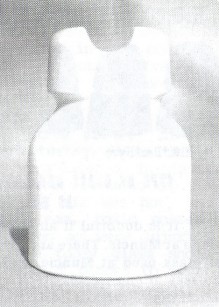
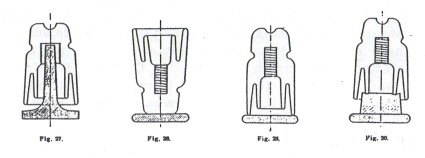
|
